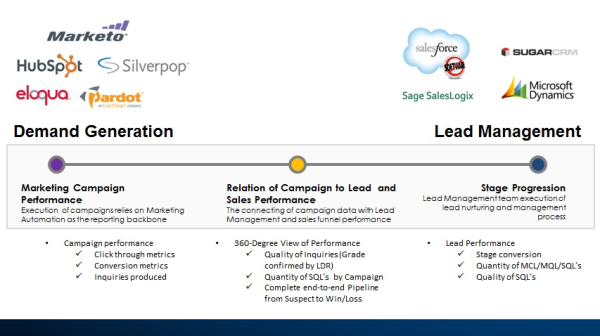Marketing leaders are in a unique position to embrace Big Data. Marketing professionals have largely embraced the analysis of data. Campaign data is highly scrutinized for insights. Customer research data is routinely analyzed with the gusto of seeking the Holy Grail. In many ways, today’s Big Data capability is the answers to every marketer’s dreams.
What’s new to the scene is the unprecedented capabilities to host, analyze and serve data. Storage is cheaper than ever. Massive databases can be stored in the cloud. Powerful analytics tools can crunch the data.
However, companies are struggling to get meaningful Big Data projects off the ground. My peers routinely share stories of clients who report that initiatives fail. The most common culprit for failure is trying to be too “BIG” all at once. The sheer nature of Big Data tends to generate massive data land grabs that paralyze the effort. The problem is the drive to go big in one leap. The size of the effort causes the initiative to fall on its face.
There is a common thread observed in successful new Big Data initiatives. Start with a limited scope as the foundation. This approach allows for momentum to be created. Success can be built onto with additional data sources to enrich the insights.
Download the Big Data Source Checklist to get started with the building of your foundation.
Leveraging Big Data in Marketing
Where do you start?
Gartner’s definition of Big Data:
Big Data is high-volume, high-velocity, and/or high-variety information assets that require new forms of processing to enable enhanced decision making, insight discovery and process optimization.
This definition succinctly captures the full meaning of Big Data. The core of the opportunity is to leverage data to produce actionable insights. These insights help improve decision making and optimize marketing processes.
Marketing performance can be greatly enhanced with insights derived from Big Data.
Benefits include;
- Enhanced campaign performance
- Optimized product development
- Enriched product marketing
- Improved customer loyalty
- Faster new product speed to market
- Uncover new customer segments/opportunities
Improved Decision Making – Building the Foundation
Marketing teams have an insatiable appetite for campaign analysis. What is often missed in campaign analysis is the full picture of performance. Marketers focus on the performance of the campaign without the full picture. The key is how the campaign results ended up performing for the business. Did the campaign produce Activity or Results?
CMO’s demand results from their teams. Big Data is a short-cut to success for driving tangible marketing results.
In the diagram below you will find typical marketing metrics for campaigns. Marketing Automation systems are most often the backbone of the reporting process. The campaign data provides an incomplete picture without data from the CRM system. The first step to leveraging Big Data is to close the sales and marketing loop.

A 360-Degree view of performance is made possible by connecting data sources. In this case, marketing campaign data is connected with lead management data. True actionable insights are then generated. Marketers look at the quantity and quality of leads from a given campaign.
Going a step further, sales pipeline data is connected to campaigns. Campaigns can then be optimized based on factual business result.
In the past, a marketing manager optimized campaigns based on cost per lead (CPL). The second measure was quantity of leads produced. Too often these metrics had the risk of de-optimizing the marketing mix. For example, Webinars can produce higher quality leads, yet cost 3x more than banner ad leads. Experiential events can be expensive to execute but produce high impact leads.
Actionable Insights
Understanding the true performance of campaigns produces actionable insights. Leads that come from the competitive bidding (Google AdWords) have a direct correlation between cost and quality. Optimizing cost without the full picture of quality will de-optimize an Adword campaign. For example, $10 leads for a complex sale that closes at a rate of 10% are better than $7 leads that close at a rate of 3%. It’s all relative to performance. Optimizing on cost per lead would have resulted in a mistake. Big Data capabilities enable marketing to perfectly optimize campaigns.
Realizing the true value of multi-touch attribution is a major function of Big Data. Marketers often chase their tail by calculating marketing ROI based on last touch attribution for a lead. This limited view dismisses the total accumulative impact of multiple touch-points. The view can diminish the stated value of nurture email campaigns. Also, the touch-points may come from both marketing and sales. Analyze the impact of marketing messages received (clicks) and sales recorded activities in the CRM.
Big Data capabilities provide the toolset to generate meaningful insights. Start with connecting existing marketing campaign data with CRM data. This is low hanging fruit that gives the CMO a strong foundation to build upon.
Once this base foundation is in place, look to enrich insights by adding data;
- Product usage
- Customer behavior/feedback
- NPS scores
- Third party data to grade/score
- Funnel stage progression
Key Takeaway:
Chief Marketing Offers are in a unique position to leverage Big Data. The roadmap to Big Data success is within reach of CMOs. Start Big Data initiatives by connecting marketing and sales data. Once this foundation is in place, begin enriching the data. This proven framework provides marketing with improved decision making and process optimization. Now is the time to get started with Big Data by downloading the Big Data Source Checklist.



